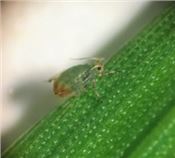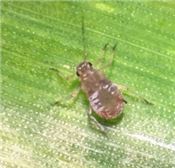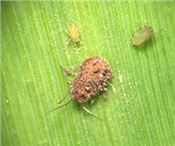Entomopathogenic Fungus May Cause High Mortality On Aphids
YAZIRI GONZALEZ AND DR. PAUL VILLANUEVA
PRINCETON, KY.
The bird cherry-oat aphid, Rhopalosiphum padi (Figure 1), is one of the common aphids found in Kentucky on small grains, such as winter wheat and barley. R. padi is of economic importance due to the direct damage caused to grains by the transmission of barley yellow dwarf virus (BYDV). Infection by BYDV in early growth stages of the host plant are the most damaging since it can stunt growth of the crop and produce heads of reduced size. Bird cherry-oat aphid populations are generally managed by natural predators, such as parasitic wasps, lady beetle larvae, lacewing larvae, and hoverflies.
On March 30, 2017, a large population of the bird cherry-oat aphid was detected in a barley field in Logan County located in Western Kentucky. The numbers of aphids per row foot were above the economic threshold (our aphid tallies in this field were greater than 100 aphids per row foot), despite the field being treated twice with a synthetic pyrethroid. Aphid-infested barley plants were taken to the lab for further evaluation on pesticide resistance. Upon examining the samples in the laboratory, fungal spores (Figure 2a) were spotted on the blades of barley with moribund (dead) aphids. A small study was conducted with four different concentrations of Baythroid and a water control. The study consisted of three replication each with two 4-centimeter blades of barley and ten aphids per Petri dish. The effect of the pesticide was monitored at 24 hours and the results will be discussed in a later publication. However, there was a significant mortality due to the fungal spores in all treatments (Figure 2b); about 43 ± 0.66 (mean ± SEM) percent of the aphids in the water control replicates were affected by unidentified entomopathogenic fungi.
The occurrence of this entomopathogenic fungi could be due to the warmer temperatures and high humidity resulting from rains occurring across Western Kentucky. Insect-killing fungi thrive in humid environments, which allow fungal spores to spread throughout soil and ultimately aphid populations.
Upon this finding, under the current conditions in Western Kentucky, entomopathogenic fungi might cause mortalities on aphids and preventative sprays with synthetic pyrethroids may be unnecessary. ∆
YAZIRI GONZALEZ: Entomologist, University of Kentucky
DR. RAUL VILLANUEVA: Extension Entomologist, University of Kentucky

Adult bird cherry-oat aphid
Photos: Yaziri Gonzalez, UK

Naturally occurring unknown fungal spores developing on bird cherry-oat aphid
nymph were collected from a Logan County barley field.

Bird cherry-oat adult killed by the naturally occurring unknown fungi.